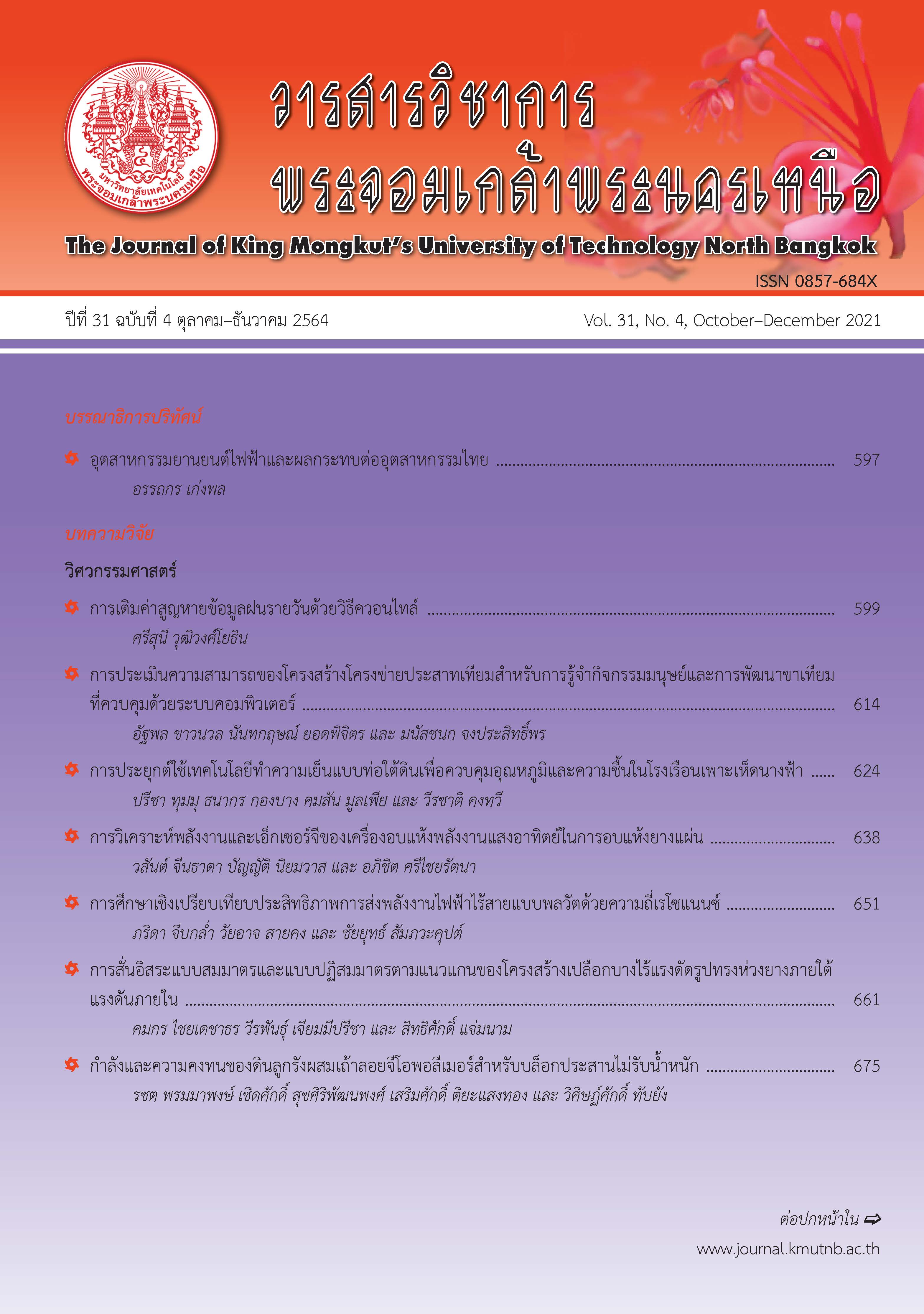ปัจจัยของการแทนที่เอฟจีดียิปซัมและอัตราส่วนของสารละลายด่างต่อกำลังรับแรงอัดและโครงสร้างทางจุลภาคของเถ้าลอยจีโอพอลิเมอร์
Main Article Content
บทคัดย่อ
งานวิจัยนี้มีจุดประสงค์เพื่อศึกษาปัจจัยของการแทนที่เอฟจีดียิปซั่มต่อกำลังรับแรงอัดและโครงสร้างทางจุลภาคของ
เถ้าลอยจีโอโพลิเมอร์ โดยการใช้เอฟจีดียิปซั่มแทนที่เถ้าลอยในปริมาณร้อยละ 0, 10, 20 และ 30 โดยน้ำหนักวัสดุประสาน สารละลายด่างที่ใช้ในการเกิดปฏิกิริยา ได้แก่ สารละลายโซเดียมซิลิเกตและสารละลายโซเดียมไฮดรอกไซด์เข้มข้น 10 โมลาร์ โดยแปรผันอัตราส่วนสารละลายโซเดียมซิลิเกตต่อสารละลายโซเดียมไฮดรอกไซด์เท่ากับ 1.0, 1.5, 2.0 และ 2.5 โดยน้ำหนัก อัตราส่วนของเหลวต่อวัสดุประสานเท่ากับ 0.60 และบ่มที่อุณหภูมิห้องทุกอัตราส่วนผสม ผลการทดสอบ พบว่า ระยะเวลาการก่อตัวของเถ้าลอยจีโอโพลิเมอร์มอร์ต้าร์มีแนวโน้มลดลงตามปริมาณการแทนที่เอฟจีดียิปซั่มและอัตราส่วนสารละลายโซเดียมซิลิเกตต่อสารละลายโซเดียมไฮดรอกไซด์ที่เพิ่มขึ้น การแทนที่เอฟจีดียิปซั่มในเถ้าลอยมีแนวโน้มส่งผลต่อกำลังอัดของจีโอโพลิเมอร์มอร์ต้าร์มากกว่าอัตราส่วนสารละลายโซเดียมซิลิเกตต่อสารละลายโซเดียมไฮดรอกไซด์ นอกจากนี้ผลการวิเคราะห์องค์ประกอบทางแร่และโครงสร้างทางจุลภาคของเถ้าลอยจีโอโพลิเมอร์ผสมเอฟจีดียิปซั่มเมื่อแปรผันอัตราส่วนสารละลายโซเดียมซิลิเกตต่อสารละลายโซเดียมไฮดรอกไซด์สอดคล้องกับผลการทดสอบกำลังอัดของเถ้าลอยจีโอโพลิเมอร์ จากผลการทดสอบข้างต้นสามารถสรุปได้ว่าปริมาณการใช้เอฟจีดียิปซั่มในเถ้าลอยร้อยละ 10 และอัตราส่วนสารละลายโซเดียมซิลิเกตต่อสารละลายโซเดียมไฮดรอกไซด์เท่ากับ 1.0 และ 1.5 เป็นอัตราส่วนที่เหมาะสมต่อการพัฒนากำลังอัดของจีโอโพลิเมอร์มอร์ต้าร์จากเถ้าลอยผสมเอฟจีดียิปซั่ม
Article Details
บทความที่ลงตีพิมพ์เป็นข้อคิดเห็นของผู้เขียนเท่านั้น
ผู้เขียนจะต้องเป็นผู้รับผิดชอบต่อผลทางกฎหมายใดๆ ที่อาจเกิดขึ้นจากบทความนั้น
เอกสารอ้างอิง
[2] S. Hanjitsuwan, T. Phoo-ngernkham, L.Y. Li, N. Damrongwiriyanupap, and P. Chindaprasirt, “Strength development and durability of alkali-activated fly ash mortar with calcium carbide residue as additive,” Construction and Building Materials, vol. 162 , pp. 714–723, 2018.
[3] S. Pangdaeng, T. Phoo-ngernkham, V. Sata, and P. Chindaprasirt, “Influence of curing conditions on properties of high calcium fly ash geopolymer containing Portland cement as additive,” Materials & Design, vol. 53, pp. 269–274, 2014.
[4] T. Phoo-ngernkham, P. Chindaprasirt, V. Sata, S. Pangdaeng, and T. Sinsiri, “Properties of high calcium fly ash geopolymer containing Portland cement additive,” International Journal of Minerals, Metallurgy and Materials, vol. 20, no. 2, pp. 214–220, 2013.
[5] I. Garcia-Lodeiro, A. Palomo, A. Fernandez-Jimenez, and D.E. MacPhee, “Effect of calcium additions on N-A-S-H cementitious gels,” Journal of the American Ceramic Society, vol. 93, no. 7, pp. 1934–1940, 2010.
[6] J. Kaweewong, “Using flue gas desulfurization (FGD) gypsum, by-product of coal-fired power plants in agriculture,” King Mongkut’s Agricultural Journal, vol. 36, no. 1, pp. 161–172, 2018 (in Thai).
[7] Standard test method for time of setting of hydrualic cement by vicat needle, ASTM C191-13, 2013.
[8] Standard test method of compressive strength of hydrualic cement mortars (using 2-in. or [50 mm] cube speciments), ASTM C109, 2002.
[9] T. Phoo-ngernkham, C. Phiangphimai, D. Intarabut, S . Hanjitsuwan, N. Damrongwiriyanupap, L.Y. Li, and P. Chindaprasirt, “Low cost and sustainable repair material made from alkali-activated high-calcium fly ash with calcium carbide residue,” Construction and Building Materials, vol. 247, pp. 118543, 2020.
[10] Standard specification for epoxy-resin-base bonding systems for concrete, ASTM C881/C881M-14, 2014.
[11] P. Chindaprasirt, P. De Silva, K. Sagoe-Crenstil, and S. Hanjitsuwan, “Effect of SiO2 and Al2O3 on the setting and hardening of high calcium fly ash-based geopolymer systems,” Journal of Materials Science, vol. 47, no. 12, pp. 4876–4883, 2012.
[12] K. Boonserm, V. Sata, K. Pimraksa, and P. Chindaprasirt, “Improved geopolymerization of bottom ash by incorporating fly ash and using waste gypsum as additive,” Cement and Concrete Composites, vol. 34, no. 7, pp. 819–824, 2012.
[13] U. Rattanasak, K. Pankhet, and P. Chindaprasirt, “Effect of chemical admixtures on properties of high-calcium fly ash geopolymer,” International Journal of Minerals, Metallurgy and Materials, vol. 18, no. 3, pp. 364–369, 2011.
[14] X. Guo, H. Shi, L. Chen, and W.A. Dick, “Alkaliactivated complex binders from class C fly ash and Ca-containing admixtures,” Journal of Hazardous Materials, vol. 173, no. 1–3, pp. 480–486, 2010.
[15] I. Garcia-Lodeiro, A. Palomo, A. Fernandez-Jimenez, and D.E. MacPhee, “Compatibility studies between N-A-S-H and C-A-S-H gels. Study in the ternary diagram Na2O-CaO-Al2O3-SiO 2-H2O,” Cement and Concrete Research, vol. 41, no. 9, pp. 923–931, 2011.
[16] S. Hanjitsuwan, T. Phoo-ngernkham, and N. Damrongwiriyanupap, “Comparative study using Portland cement and calcium carbide residue as a promoter in bottom ash geopolymer,” Construction and Building Materials, vol. 133, pp. 128–134, 2017.

